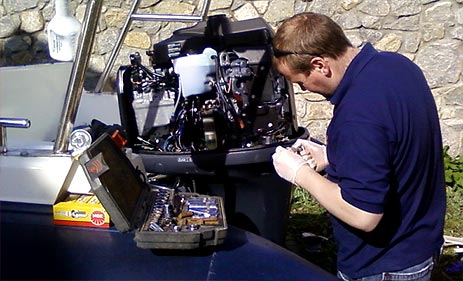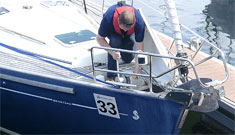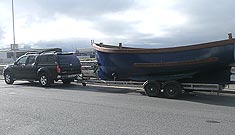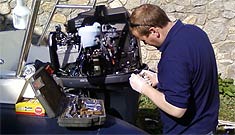| |
|
|

Barrier Coatings for Fiberglass, Steel, and Cement Hulls
Essentially a barrier coat is simply a layer of epoxy, which is highly non-porous, applied over a rather porous polyester resin fiberglass hull. The regular fiberglass hulls can selectively draw in water
and create blisters. The epoxy barrier coat seals the hull.
Despite what you may have read, barrier coat technology is not rocket science. It boils down applying a sealing coat of epoxy to your hull and basically any epoxy will do the job, in fact, from what I have
observed many paint/resin companies seem to have brought obsolete and junky epoxies back to life as barrier coatings.
Boat Blisters
Most folks make a big deal over fiberglass hull blisters. They will not sink or boat and are not worth the worry so many people give them. Consider them like teenage pimples or zits. Pop them, wash them, and medicate them (patch them) and get on with your life. If you insist upon making a big deal about them, you can always find someone willing to agree with you and charge you lots of money for whatever degree of ‘overkill' you are willing to pay them for.
Rotting Wood and Ethylene Glycol
I don't know why the use of Ethylene Glycol (ie. regular automotive Antifreeze) to kill and treat the fungus that causes wood rot causes such strong reactions in many people. Obviously the best solution
to rot is to cut it out completely and replace the damaged area. If you cannot or will not do that (such as on the top surface of an otherwise good wooden dock piling), then liberal use of antifreeze
on the rotting wood will kill the fungus. The antifreeze will evaporate, leaving begin just a slight residue. The rot fungus will eventually return - the glycol have evaporated away. The wood is still damaged
and rotted, but at least you've checked the rotting for the moment. If somehow patched or coated/repaired the rotting will probably not continue hidden under the patch.
Repairing Hairlne Cracks in old fiberglass hulls
All old fiberglass hulls seem to have them - lots and lots of tiny spider web like, gel coat cracks. These hairline cracks are ugly and can let moisture into the hull.
Here's my thoughts (and tests) on how to repair:
1) sand the hull cracks smooth (as these crack age they seem to sometimes lift and curl along the crack edges).
2) coat the area with our aluthane aluminum primer. The very thin aluthane will be drawn into the crack to help seal it and at the same time prime the surrounding fiberglass.
3) paint hull with a coat of our very brushable, 100% solids (0% VOC) Low V epoxy. This will actually cover the cracks and vanish them under a layer of epoxy.
4) sand the epoxy/hull smooth
5) paint the hull.
|
|

BOAT MAINTENANCE To ensure the maximum enjoyment of the season, Truelight Marine offer service programs, available weekly to suit your needs. more about boat maintenance >>

BOAT SAFETY While accidents do happen, knowledge and preparation go a long way toward returning to the dock safely. more about boat safety >>

TRANSPORTING YOUR BOAT We provide door to door service and base our business on customer service and satisfaction. We never compromise on these beliefs. more about our boat transport >>
|
|




